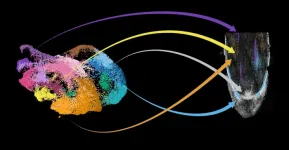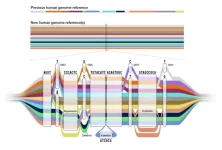Ohio State professor elected to National Academy of Sciences
Weinberg is first-ever Ohio State astronomer to receive membership
2023-05-10
(Press-News.org) COLUMBUS, Ohio - An Ohio State University astronomy professor has been elected to the National Academy of Sciences, one of the highest honors a scientist can receive in the U.S.
David Weinberg, Distinguished University Professor and chair of astronomy, is among 120 new members and 23 international members from 13 countries who were inducted this year in recognition of distinguished and continuing achievement in original research inside their chosen field.
“I have been lucky to have great students and great colleagues throughout my 28 years at Ohio State,” said Weinberg. “It’s just very gratifying to know that your colleagues really recognize and appreciate the work that you do.”
Throughout his career, Weinberg’s work in cosmology has investigated the matter and energy contents of the universe, the formation of galaxies, and the origin of the chemical elements. He is also known for his theoretical work, using supercomputer simulations of dark matter and galaxy clustering, and for his leading roles in cosmological surveys, especially the Sloan Digital Sky Surveys.
“Professor Weinberg’s election into the highly prestigious National Academy of Sciences is a testament of his career dedicated to research, scholarship and to deepening our understanding of the universe around us,” said Peter Mohler, interim executive vice president of research, innovation and knowledge at Ohio State.
Weinberg becomes the first astronomer from Ohio State to have been elected to the National Academy of Sciences. According to Weinberg, it was possible to flourish because Ohio State is an ideal space for the exchange of ideas.
“What has made Ohio State astronomy so great is that we recruit terrific people and create an environment where they can do better science here than they could anywhere else,” said Weinberg. “As I now become someone who can elect members in the future, I hope to nominate some other great people from public universities.”
Weinberg received his B.S in physics at Yale University and his Ph.D. in astrophysics at Princeton University. His previous recognitions include the 2021 Dannie Heineman Prize awarded by the American Astronomical Society and the American Institute of Physics.
Weinberg joins 11 other Ohio State faculty who are members of the National Academy of Sciences.
A private, nonprofit society, the National Academy of Sciences was originally established by Abraham Lincoln during the Civil War to provide scientific advice to the government. Now an advisory body with more than 2,500 active members, its various committees and panels have helped direct a number of scientific and military projects, including future NASA missions and potential telescope proposals.
#
Contact: David Weinberg, Weinberg.21@osu.edu
Written by: Tatyana Woodall, Woodall.5@osu.edu
END
ELSE PRESS RELEASES FROM THIS DATE:
2023-05-10
CLEVELAND - Inhibiting a protein on the surface of immune cells could offer new strategies for treating severe asthma, Cleveland Clinic researchers found.
Researchers discovered a new way a protein called MCEMP1 contributes to severe inflammation in the airway and lungs. The discovery, published in Nature Communications, provides critical information for developing therapeutic interventions to treat long-term lung conditions, including asthma, on a biological level.
The study was conducted in a lab led by Jae Jung, PhD, chair ...
2023-05-10
A group of researchers led by Andreas Wallraff, Professor of Solid State Physics at ETH Zurich, has performed a loophole-free Bell test to disprove the concept of “local causality” formulated by Albert Einstein in response to quantum mechanics. By showing that quantum mechanical objects that are far apart can be much more strongly correlated with each other than is possible in conventional systems, the researchers have provided further confirmation for quantum mechanics. What’s special about ...
2023-05-10
Philadelphia, May 10, 2023 – The dairy industry has seen a revolution over the past two decades in fertility success within herds. Widely adopted fertility programs are at the heart of this leap forward, along with the industry’s increased understanding—and optimization—of the holistic interactions among the body condition, overall health, and fertility of a dairy cow. In a recent mini-review appearing in a special fertility issue of JDS Communications®, published by Elsevier, researchers from the University of ...
2023-05-10
Researchers have released a new high-quality collection of reference human genome sequences that captures substantially more diversity from different human populations than what was previously available. The work was led by the international Human Pangenome Reference Consortium, a group funded by the National Human Genome Research Institute (NHGRI), part of the National Institutes of Health.
The new “pangenome” reference includes genome sequences of 47 people, with the researchers pursuing the goal of increasing that number to 350 by mid-2024. With each person carrying a paired set of chromosomes, the current reference actually includes 94 distinct genome ...
2023-05-10
Comparing individual cells across corn, sorghum, and millet reveals evolutionary differences among these important cereal crops, according to a new study led by New York University researchers.
The findings, published in Nature, bring researchers closer to pinpointing which genes control important agricultural traits such as drought tolerance, which will help scientists faced with a changing climate adapt crops to drier environments.
Corn, sorghum, and millet provide food for humans and animals around the world. Corn and sorghum are ancient relatives that evolved into two different species roughly 12 million years ago, and millet is a more distant relative.
Despite ...
2023-05-10
EMBARGOED UNTIL WEDNESDAY, MAY 10, 2023, AT 11AM ET
New York, NY (May 10, 2023)—Eimear Kenny, PhD, had just completed undergrad and was working in her first computational genomics job more than 20 years ago when scientists announced the first (nearly) complete sequencing of the human genome—what was considered at the time to be the fundamental blueprint for all humans. The Human Genome Project aimed to map the entire genome in an effort to accelerate the diagnosis and eventual treatment of common and rare diseases.
Now, Dr. Kenny, ...
2023-05-10
UC Santa Cruz scientists, along with a consortium of researchers, have released a draft of the first human pangenome—a new, usable reference for genomics that combines the genetic material of 47 individuals from different ancestral backgrounds to allow for a deeper, more accurate understanding of worldwide genomic diversity.
By adding 119 million bases—the “letters” in DNA sequences—to the existing genomics reference, the pangenome provides a representation of human genetic diversity that was not possible with a single reference genome. It is highly accurate, more complete and dramatically increases ...
2023-05-10
New Haven, Conn. — When it was launched in April 2003, the Human Genome Project helped revolutionize biomedical research by providing scientists a reference map that allowed them to analyze DNA sequences for genetic clues to the origins of a host of diseases.
Twenty years later, a team of researchers that includes Yale scientists has created a new “pangenome” that fills in missing sequencing gaps from the original genome project and greatly expands the diversity of genomes represented.
The achievement is described in ...
2023-05-10
One of the most important advances in palliative care in oncology over the past 15 years has been the recognition that palliative care specialists can improve cancer patients’ outcomes well before their end of life.
Palliative care is specialized care provided to individuals with a serious illness that focuses on decision-making support, pain and symptom management, as well as psychosocial interventions to improve quality of life.
Several past randomized clinical trials have shown palliative care specialists can improve the quality of life and lengthen the ...
2023-05-10
About The Study: In this study, key thematic shifts and increases in language related to anxiety, anger, depression, and loneliness were identified in the content posted on social media by academic emergency medicine physicians and resident physicians during the pandemic. Social media may provide a real-time and evolving landscape to evaluate thematic content and linguistics related to emotions and sentiment for health care workers.
Authors: Anish K. Agarwal, M.D., M.P.H., M.S., of the ...
LAST 30 PRESS RELEASES:
[Press-News.org] Ohio State professor elected to National Academy of Sciences
Weinberg is first-ever Ohio State astronomer to receive membership






